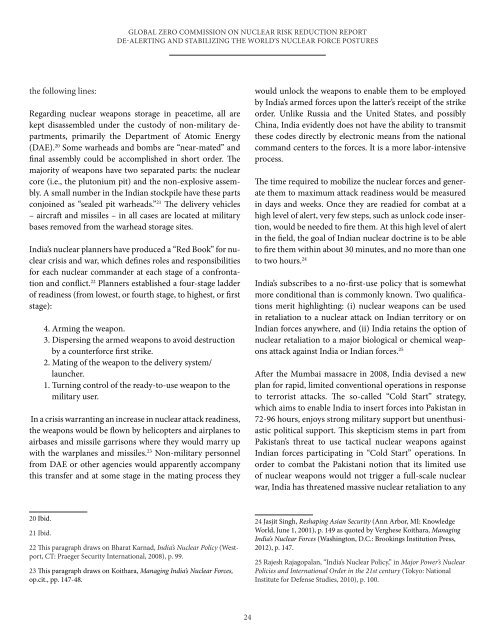global_zero_commission_on_nuclear_risk_reduction_report
global_zero_commission_on_nuclear_risk_reduction_report
global_zero_commission_on_nuclear_risk_reduction_report
Create successful ePaper yourself
Turn your PDF publications into a flip-book with our unique Google optimized e-Paper software.
GLOBAL ZERO COMMISSION ON NUCLEAR RISK REDUCTION REPORTDE-ALERTING AND STABILIZING THE WORLD’S NUCLEAR FORCE POSTURESthe following lines:Regarding <strong>nuclear</strong> weap<strong>on</strong>s storage in peacetime, all arekept disassembled under the custody of n<strong>on</strong>-military departments,primarily the Department of Atomic Energy(DAE). 20 Some warheads and bombs are “near-mated” andfinal assembly could be accomplished in short order. Themajority of weap<strong>on</strong>s have two separated parts: the <strong>nuclear</strong>core (i.e., the plut<strong>on</strong>ium pit) and the n<strong>on</strong>-explosive assembly.A small number in the Indian stockpile have these partsc<strong>on</strong>joined as “sealed pit warheads.” 21 The delivery vehicles– aircraft and missiles – in all cases are located at militarybases removed from the warhead storage sites.India’s <strong>nuclear</strong> planners have produced a “Red Book” for <strong>nuclear</strong>crisis and war, which defines roles and resp<strong>on</strong>sibilitiesfor each <strong>nuclear</strong> commander at each stage of a c<strong>on</strong>fr<strong>on</strong>tati<strong>on</strong>and c<strong>on</strong>flict. 22 Planners established a four-stage ladderof readiness (from lowest, or fourth stage, to highest, or firststage):4. Arming the weap<strong>on</strong>.3. Dispersing the armed weap<strong>on</strong>s to avoid destructi<strong>on</strong>by a counterforce first strike.2. Mating of the weap<strong>on</strong> to the delivery system/launcher.1. Turning c<strong>on</strong>trol of the ready-to-use weap<strong>on</strong> to themilitary user.In a crisis warranting an increase in <strong>nuclear</strong> attack readiness,the weap<strong>on</strong>s would be flown by helicopters and airplanes toairbases and missile garris<strong>on</strong>s where they would marry upwith the warplanes and missiles. 23 N<strong>on</strong>-military pers<strong>on</strong>nelfrom DAE or other agencies would apparently accompanythis transfer and at some stage in the mating process theywould unlock the weap<strong>on</strong>s to enable them to be employedby India’s armed forces up<strong>on</strong> the latter’s receipt of the strikeorder. Unlike Russia and the United States, and possiblyChina, India evidently does not have the ability to transmitthese codes directly by electr<strong>on</strong>ic means from the nati<strong>on</strong>alcommand centers to the forces. It is a more labor-intensiveprocess.The time required to mobilize the <strong>nuclear</strong> forces and generatethem to maximum attack readiness would be measuredin days and weeks. Once they are readied for combat at ahigh level of alert, very few steps, such as unlock code inserti<strong>on</strong>,would be needed to fire them. At this high level of alertin the field, the goal of Indian <strong>nuclear</strong> doctrine is to be ableto fire them within about 30 minutes, and no more than <strong>on</strong>eto two hours. 24India’s subscribes to a no-first-use policy that is somewhatmore c<strong>on</strong>diti<strong>on</strong>al than is comm<strong>on</strong>ly known. Two qualificati<strong>on</strong>smerit highlighting: (i) <strong>nuclear</strong> weap<strong>on</strong>s can be usedin retaliati<strong>on</strong> to a <strong>nuclear</strong> attack <strong>on</strong> Indian territory or <strong>on</strong>Indian forces anywhere, and (ii) India retains the opti<strong>on</strong> of<strong>nuclear</strong> retaliati<strong>on</strong> to a major biological or chemical weap<strong>on</strong>sattack against India or Indian forces. 25After the Mumbai massacre in 2008, India devised a newplan for rapid, limited c<strong>on</strong>venti<strong>on</strong>al operati<strong>on</strong>s in resp<strong>on</strong>seto terrorist attacks. The so-called “Cold Start” strategy,which aims to enable India to insert forces into Pakistan in72-96 hours, enjoys str<strong>on</strong>g military support but unenthusiasticpolitical support. This skepticism stems in part fromPakistan’s threat to use tactical <strong>nuclear</strong> weap<strong>on</strong>s againstIndian forces participating in “Cold Start” operati<strong>on</strong>s. Inorder to combat the Pakistani noti<strong>on</strong> that its limited useof <strong>nuclear</strong> weap<strong>on</strong>s would not trigger a full-scale <strong>nuclear</strong>war, India has threatened massive <strong>nuclear</strong> retaliati<strong>on</strong> to any20 Ibid.21 Ibid.22 This paragraph draws <strong>on</strong> Bharat Karnad, India’s Nuclear Policy (Westport,CT: Praeger Security Internati<strong>on</strong>al, 2008), p. 99.23 This paragraph draws <strong>on</strong> Koithara, Managing India’s Nuclear Forces,op.cit., pp. 147-48.24 Jasjit Singh, Reshaping Asian Security (Ann Arbor, MI: KnowledgeWorld, June 1, 2001), p. 149 as quoted by Verghese Koithara, ManagingIndia’s Nuclear Forces (Washingt<strong>on</strong>, D.C.: Brookings Instituti<strong>on</strong> Press,2012), p. 147.25 Rajesh Rajagopalan, “India’s Nuclear Policy,” in Major Power’s NuclearPolicies and Internati<strong>on</strong>al Order in the 21st century (Tokyo: Nati<strong>on</strong>alInstitute for Defense Studies, 2010), p. 100.24


